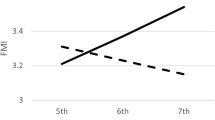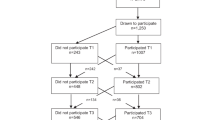Abstract
Objective:
To examine whether factors common to obesity prevention programmes in adolescence, namely exercise, sedentary activities, eating behaviours and psychological factors, predict change in BMI in ‘free-living’ adolescents followed into adulthood.
Design:
Longitudinal national birth cohort study.
Subjects:
1970 British Birth Cohort: 4461 subjects with data on BMI at 16 years (1986) and 30 years (2000).
Measurements and analysis:
BMI z-score (zBMI) at 16 years (measured) and 30 years (self-reported). Obesity defined as BMI exceeding 95th British centile and 28.5 kg/m2, respectively. Self-report data on exercise, eating behaviours, dieting and measures of psychological function (depression, psychological distress, self-esteem) at 16 years. Models were produced for the regression of zBMI at 30 years on each variable at 16 years, adjusted for socioeconomic status, sex and zBMI at 16 years.
Results:
In all, 467 (8.2%) were obese at 16 years and 730 (16.4%) were obese at 30 years. Of those obese at 16 years, 60.7% were also obese at 30 years. Loss of zBMI between 16 and 30 years was predicted by female sex (P=0.01), higher social class (P<0.0001) and higher frequency of playing sport, although this was of borderline significance (P=0.05). Increase in zBMI between 16 and 30 years was predicted by 4 or more hours per day of sedentary activities (P=0.01), eating takeaway meals twice or more per week (P=0.009), consuming two or more carbonated drinks per day (P=0.04) and a history of dieting to lose weight (P=0.04).
Conclusion:
These data from ‘free-living’ adolescents followed into adult life support the importance of known risk factors such as reduction of sedentary behaviours and reduction of unhealthy eating patterns (consumption of carbonated drinks and takeaway foods, dieting) in the prevention of the persistence of obesity from childhood into adult life.
This is a preview of subscription content, access via your institution
Access options
Subscribe to this journal
Receive 12 print issues and online access
$259.00 per year
only $21.58 per issue
Buy this article
- Purchase on Springer Link
- Instant access to full article PDF
Prices may be subject to local taxes which are calculated during checkout
Similar content being viewed by others
References
Reilly JJ, Methven E, McDowell ZC, Hacking B, Alexander D, Stewart L et al. Health consequences of obesity. Arch Dis Child 2003; 88: 748–752.
Gordon-Larsen P, Adair LS, Nelson MC, Popkin BM . Five-year obesity incidence in the transition period between adolescence and adulthood: the National Longitudinal Study of Adolescent Health. Am J Clin Nutr 2004; 80: 569–575.
Parsons TJ, Power C, Logan S, Summerbell CD . Childhood predictors of adult obesity: a systematic review. Int J Obes Relat Metab Disord 1999; 23 (Suppl 8): S1–S107.
Lake JK, Power C, Cole TJ . Child to adult body mass index in the 1958 British birth cohort: associations with parental obesity. Arch Dis Child 1997; 77: 376–381.
Power C, Manor O, Matthews S . Child to adult socioeconomic conditions and obesity in a national cohort. Int J Obes Relat Metab Disord 2003; 27: 1081–1086.
Campbell K, Waters E, O’Meara S, Kelly S, Summerbell CD . Interventions for preventing obesity in children (Cochrane Review). In: The Cochrane Library, Oxford: 2003.
Hancox RJ, Milne BJ, Poulton R . Association between child and adolescent television viewing and adult health: a longitudinal birth cohort study. Lancet 2004; 364: 257–262.
Goodman A, Butler N . BCS70 – The 1970 British Birth Cohort; The Sixteen Year Follow-up. Social Statistics Research Unit, City University: London, 1991.
Goldberg D, Williams P . The Users’ Guide to the General Health Questionnaire. NFER-Nelson: Windsor, 1988.
Rutter M, Tizard J, Whitmore K . Education, Health and Behaviour. Longmans: London, 1970.
Thorpe K, Golding J, MacGillivray I, Greenwood R . Comparison of prevalence of depression in mothers of twins and mothers of singletons. BMJ 1991; 302: 875–878.
Rodgers B, Pickles A, Power C, Collishaw S, Maughan B . Validity of the Malaise Inventory in general population samples. Soc Psychiatry Psychiatr Epidemiol 1999; 34: 333–341.
Lawrence D . Improved Reading through Counselling. Ward Lock: London, 1973.
Hart JG . LAWSEQ: its relation to other measures of self-esteem and academic ability. Br J Educ Psychol 1982; 22: 167–169.
Spencer EA, Appleby PN, Davey GK, Key TJ . Validity of self-reported height and weight in 4808 EPIC-Oxford participants. Public Health Nutr 2002; 5: 561–565.
Angold A, Costello EJ, Worthman CM . Puberty and depression: the roles of age, pubertal status and pubertal timing. Psychol Med 1998; 28: 51–61.
Bolton-Smith C, Woodward M, Tunstall-Pedoe H, Morrison C . Accuracy of the estimated prevalence of obesity from self reported height and weight in an adult Scottish population. J Epidemiol Commun Health 2000; 54: 143–148.
Goodman E, Strauss RS . Self-reported height and weight and the definition of obesity in epidemiological studies. J Adolesc Health 2003; 33: 140–141.
Ball K, Brown W, Crawford D . Who does not gain weight? Prevalence and predictors of weight maintenance in young women. Int J Obes Relat Metab Disord 2002; 26: 1570–1578.
Levin S, Lowry R, Brown DR, Dietz WH . Physical activity and body mass index among US adolescents: youth risk behavior survey, 1999. Arch Pediatr Adolesc Med 2003; 157: 816–820.
Tammelin T, Laitinen J, Nayha S . Change in the level of physical activity from adolescence into adulthood and obesity at the age of 31 years. Int J Obes Relat Metab Disord 2004; 28: 775–782.
Raitakari OT, Porkka KV, Taimela S, Telama R, Rasanen L, Viikari JS . Effects of persistent physical activity and inactivity on coronary risk factors in children and young adults. The Cardiovascular Risk in Young Finns Study. Am J Epidemiol 1994; 140: 195–205.
Twisk JW, Van Mechelen W, Kemper HC, Post GB . The relation between ‘long-term exposure’ to lifestyle during youth and young adulthood and risk factors for cardiovascular disease at adult age. J Adolesc Health 1997; 20: 309–319.
Kimm SY, Glynn NW, Obarzanek E, Kriska AM, Daniels SR, Barton BA et al. Relation between the changes in physical activity and body-mass index during adolescence: a multicentre longitudinal study. Lancet 2005; 366: 301–307.
Reilly JJ, McDowell ZC . Physical activity interventions in the prevention and treatment of paediatric obesity: systematic review and critical appraisal. Proc Nutr Soc 2003; 62: 611–619.
Siega-Riz AM, Popkin BM, Carson T . Trends in breakfast consumption for children in the United States from 1965–1991. Am J Clin Nutr 1998; 67: 748S–756S.
Bellisle F, Rolland-Cachera MF, Deheeger M, Guilloud-Bataille M . Obesity and food intake in children: evidence for a role of metabolic and/or behavioral daily rhythms. Appetite 1988; 11: 111–118.
Ortega RM, Requejo AM, Lopez-Sobaler AM, Quintas ME, Andres P, Redondo MR et al. Difference in the breakfast habits of overweight/obese and normal weight schoolchildren. Int J Vitam Nutr Res 1998; 68: 125–132.
Summerbell CD, Moody RC, Shanks J, Stock MJ, Geissler C . Relationship between feeding pattern and body mass index in 220 free-living people in four age groups. Eur J Clin Nutr 1996; 50: 513–519.
Epstein LH, Valoski A, Wing RR, McCurley J . Ten-year outcomes of behavioral family-based treatment for childhood obesity. Health Psychol 1994; 13: 373–383.
Nicklas TA, Yang SJ, Baranowski T, Zakeri I, Berenson G . Eating patterns and obesity in children. The Bogalusa Heart Study. Am J Prev Med 2003; 25: 9–16.
James J, Thomas P, Cavan D, Kerr D . Preventing childhood obesity by reducing consumption of carbonated drinks: cluster randomised controlled trial. BMJ 2004; 328: 1237.
Ludwig DS, Peterson KE, Gortmaker SL . Relation between consumption of sugar-sweetened drinks and childhood obesity: a prospective, observational analysis. Lancet 2001; 357: 505–508.
Thompson OM, Ballew C, Resnicow K, Must A, Bandini LG, Cyr H et al. Food purchased away from home as a predictor of change in BMI z-score among girls. Int J Obes Relat Metab Disord 2004; 28: 282–289.
Strauss RS . Self-reported weight status and dieting in a cross-sectional sample of young adolescents: National Health and Nutrition Examination Survey III. Arch Pediatr Adolesc Med 1999; 153: 741–747.
Field AE, Austin SB, Taylor CB, Malspeis S, Rosner B, Rockett HR et al. Relation between dieting and weight change among preadolescents and adolescents. Pediatrics 2003; 112: 900–906.
Watson MJ, Coffey C, Carlin JB, Sawyer SM, Paton GC . Dietary restraint behaviour in adolescence and weight status in young adulthood. Asia Pac J Clin Nutr 2003; 12 (Suppl): S11.
Richardson LP, Davis R, Poulton R, McCauley E, Moffitt TE, Caspi A et al. A longitudinal evaluation of adolescent depression and adult obesity. Arch Pediatr Adolesc Med 2003; 157: 739–745.
Goodman E, Whitaker RC . A prospective study of the role of depression in the development and persistence of adolescent obesity. Pediatrics 2002; 109: 497–504.
Kimm SYS, Barton BA, Berhane K, Ross JW, Payne GH, Schreiber GB . Self-esteem and adiposity in black and white girls: The NHLBI Growth and Health study. Ann Epidemiol 1997; 7: 550–560.
French SA, Story M, Perry CL . Self-esteem and obesity in children and adolescents: a literature review. Obes Res 1995; 3: 479–490.
Brown KM, McMahon RP, Biro FM, Crawford P, Schreiber GB, Similo SL et al. Changes in self-esteem in black and white girls between the ages of 9 and 14 years. The NHLBI Growth and Health Study. J Adolesc Health 1998; 23: 7–19.
French SA, Perry CL, Leon GR, Fulkerson JA . Self-esteem and change in body mass index over 3 years in a cohort of adolescents. Obes Res 1996; 4: 27–33.
Author information
Authors and Affiliations
Corresponding author
Rights and permissions
About this article
Cite this article
Viner, R., Cole, T. Who changes body mass between adolescence and adulthood? Factors predicting change in BMI between 16 year and 30 years in the 1970 British Birth Cohort. Int J Obes 30, 1368–1374 (2006). https://doi.org/10.1038/sj.ijo.0803183
Received:
Revised:
Accepted:
Published:
Issue Date:
DOI: https://doi.org/10.1038/sj.ijo.0803183



